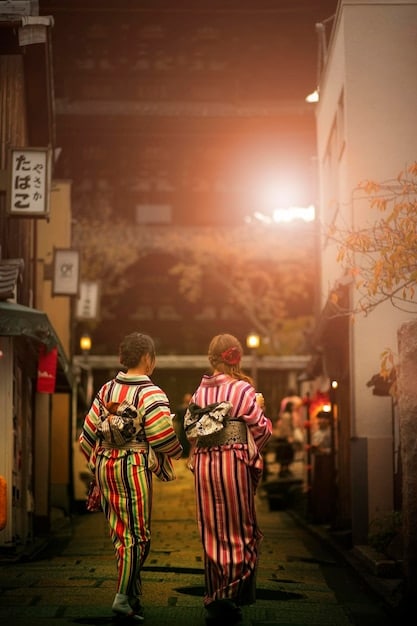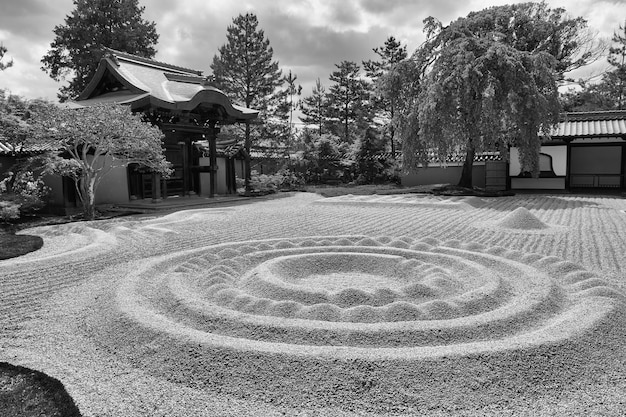Decoding Japanese Drama Endings: Ambiguity and Controversy Explained

Advertisements
Japanese drama endings often leave audiences pondering, sparking debate with their ambiguity or controversial choices, which are intentionally crafted to leave a lasting impression.
Japanese dramas, also known as J-dramas, have captivated audiences worldwide with their compelling storylines, memorable characters, and unique cultural perspectives. However, one aspect that often sparks discussion and debate is the endings. Navigating the complexities of Japanese drama endings can be challenging, as they frequently deviate from conventional Western narrative structures. These finales can range from bittersweet and open-ended to outright controversial, leaving viewers to interpret the characters’ fates and the overall message.
Anúncios
Understanding Japanese Drama Endings
Endings in Japanese dramas are not always neat and tidy. They often reflect cultural nuances and storytelling traditions that differ significantly from Western narratives. Understanding these differences is key to appreciating the intentions behind ambiguous or controversial finales. Japanese storytelling emphasizes themes like impermanence (無常, mujō), emotional depth over resolution, and the importance of audience interpretation.
Cultural Influences on Storytelling
Japanese culture deeply influences the narrative structure of J-dramas. Concepts like “wa” (和), emphasizing harmony and avoiding direct confrontation, can impact how conflicts are resolved, or sometimes, left unresolved, in the ending. Additionally, the aesthetic of “wabi-sabi” (侘寂), which finds beauty in imperfection and transience, often manifests in endings that embrace ambiguity and realism.
Anúncios
- Emphasis on Process Over Outcome: J-dramas often focus more on the journey and character development than on a clear-cut resolution.
- Emotional Resonance: The primary goal is to evoke strong emotions in the viewer, even if it means leaving some questions unanswered.
- Audience Interpretation: Endings are frequently designed to encourage viewers to reflect and draw their own conclusions.
Japanese drama endings often encourage interpretation, making the experience an engaging exercise in pondering the story’s meaning. By understanding these cultural influences, viewers can appreciate the nuanced storytelling that sets J-dramas apart.
Common Types of Ambiguous Endings
Ambiguous endings in J-dramas come in various forms, each serving a distinct purpose within the narrative. These types of endings often leave the audience questioning what truly happened and what the future holds for the characters. Recognizing these common patterns can help viewers better navigate their emotional responses and appreciate the artistry behind the storytelling.
Open-Ended Relationships
One prevalent type of ambiguous ending revolves around relationships. The romantic leads may not end up together, or their future is left uncertain. This type of ending allows viewers to ponder the possibilities and consider the characters’ personal growth, even if their romantic journey remains unresolved.
Unresolved Conflicts
Another form of ambiguity involves unresolved conflicts. Whether it’s a mystery that remains unsolved or a societal issue that persists, these endings challenge the viewers to reflect on the complexities of life. It acknowledges that not all problems can be neatly resolved, mirroring real-world experiences.

- Symbolic Closure: Even without concrete resolutions, symbolic acts or images can provide a sense of closure.
- Emphasis on Character Growth: The focus may shift from resolving the plot to highlighting how the characters have evolved throughout the series.
- Reflection of Reality: Realistic portrayals of life often include loose ends and uncertainties, which are reflected in the drama’s conclusion.
Ambiguous endings invite viewers to engage actively with the narrative, encouraging introspection and discussion about the themes presented. They resist the urge for simplistic resolutions, instead offering a more profound and lasting impact.
Why Japanese Dramas Choose Ambiguous Endings
The decision to employ ambiguous endings in Japanese dramas is often intentional, serving several artistic and cultural functions. These endings are not a result of poor writing but rather a deliberate choice to enhance the viewing experience and leave a lasting impression.
Artistic Intent
Ambiguous endings allow writers and directors to explore deeper themes and complex emotions without the constraints of a conventional resolution. This artistic freedom can lead to more thought-provoking and memorable dramas, encouraging viewers to ponder the story long after it concludes.
Cultural Values
Japanese culture values subtlety, reflection, and indirect communication. Ambiguous endings align with these cultural norms, inviting viewers to interpret the subtext and underlying meanings. Direct explanations are often avoided in favor of allowing the audience to draw their own conclusions.

- Encouraging Discussion: Ambiguous endings can spark robust discussions among viewers, fostering a sense of community and shared interpretation.
- Reflecting Real Life: Life is often ambiguous, and unresolved endings can mirror the uncertainties and complexities of human existence.
- Avoiding Forced Closure: Rather than forcing a happy ending that feels unnatural, ambiguous endings respect the integrity of the narrative and the characters’ journeys.
By embracing ambiguity, Japanese dramas create a richer and more engaging viewing experience that encourages participation and reflection. This approach transforms the narrative into a collaborative effort between creators and audiences, fostering a deeper appreciation for the art of storytelling.
Controversial Endings: When Fans React
While ambiguity can be intriguing, some Japanese drama endings venture into controversial territory, sparking strong reactions from fans. These endings often challenge expectations, defy conventional storytelling norms, or involve character choices that conflict with viewer desires. Understanding why these endings elicit such passionate responses provides insight into the cultural and emotional investments viewers have in the dramas they watch.
Unjust Character Fates
One common source of controversy stems from endings where beloved characters meet unjust or unhappy fates. Viewers become emotionally attached to these characters and their journeys, and when their stories conclude on a sour note, it can lead to disappointment and anger.
Unsatisfying Romantic Resolutions
Romantic storylines are a central element of many J-dramas, and when these narratives fail to deliver a satisfying resolution, fans often express their dissatisfaction. Disagreements over which characters should end up together or frustration with last-minute plot twists can fuel heated debates.
- Character Betrayal: When characters act out of alignment with their established personalities, it can undermine the audience’s trust and lead to negative reactions.
- Lack of Closure: Endings that leave crucial plot points unresolved or fail to address significant character arcs can feel incomplete and frustrating.
- Unexpected Twists: While plot twists can be exciting, those that feel unearned or contrived can alienate viewers.
Controversial endings, while sometimes frustrating, can also be valuable in sparking dialogue and encouraging critical analysis of the drama’s themes and messages. They push the boundaries of storytelling and challenge viewers to reconsider their expectations of what a “good” ending should be.
Decoding Specific Examples
To further illustrate the nuances of ambiguous and controversial endings, let’s examine specific examples from popular Japanese dramas. These analyses will provide a deeper understanding of how different narrative choices can impact viewer perception and spark debate.
Example 1: [Drama Title]
In [Drama Title], the ending features [brief description of the ambiguous or controversial element]. This choice led to widespread discussion because [reasons why it was controversial or ambiguous]. Some viewers interpreted it as [interpretation 1], while others saw it as [interpretation 2].
Example 2: [Drama Title]
Another notable example is [Drama Title], where the ending depicted [brief description of the ambiguous or controversial element]. Fans reacted strongly due to [reasons why it was controversial or ambiguous]. This ending was seen by some as [interpretation 1], whereas others believed it represented [interpretation 2].
- Analyzing Symbolism: Look for recurring motifs, visual cues, or dialogue that provide hints about the intended meaning of the ambiguous elements.
- Considering Character Arcs: Evaluate how the characters have evolved throughout the series and how the ending reflects their overall journey.
- Examining Cultural Context: Understand the cultural values and norms that may have influenced the creators’ decisions regarding the ending.
By dissecting these specific examples, viewers can develop a more nuanced appreciation for the artistry and intentionality behind ambiguous and controversial endings in Japanese dramas. These analyses reveal the diverse ways in which creators challenge and engage their audiences.
Tips for Appreciating Ambiguous Endings
If you find yourself frustrated by ambiguous endings in Japanese dramas, there are several strategies you can employ to enhance your viewing experience and appreciate the artistry behind these narrative choices. By shifting your perspective and embracing the uncertainty, you can discover new layers of meaning and emotional resonance.
Embrace Uncertainty
Instead of seeking a definitive resolution, allow yourself to explore the possibilities and contemplate the characters’ futures. Embrace the unknown and avoid the need for a neat and tidy conclusion.
Focus on the Journey
Shift your attention from the final outcome to the overall journey of the characters and the themes explored throughout the series. Appreciate the growth, struggles, and relationships that have shaped their experiences.
- Engage in Discussion: Share your thoughts and interpretations with other viewers to gain new perspectives and deepen your understanding.
- Consider Multiple Interpretations: Recognize that there is no single “correct” interpretation and be open to different viewpoints.
- Reflect on Personal Experiences: Connect the themes and characters in the drama to your own life experiences, allowing for a more personal and meaningful connection.
By adopting these tips, viewers can transform their frustration into appreciation, unlocking a deeper level of engagement and understanding with Japanese dramas. Ambiguous endings become an invitation to reflect, discuss, and connect with the narrative on a more profound level.
| Key Point | Brief Description |
|---|---|
| 🤔 Cultural Influences | Japanese culture impacts storytelling with concepts like ‘wa’ and ‘wabi-sabi’. |
| 💔 Open-Ended Relationships | Romantic leads may not end up together, leaving their future uncertain. |
| 🎭 Artistic Intent | Ambiguous endings explore deeper themes without conventional resolutions. |
| 🎬 Fan Reactions | Controversial endings can spark strong emotional reactions from viewers. |
Frequently Asked Questions
▼
Ambiguous endings align with Japanese cultural values that emphasize subtlety and indirect communication, encouraging viewers to reflect and interpret the story’s deeper meanings.
▼
Common elements include unjust fates for beloved characters, unsatisfying romantic resolutions, and unexpected plot twists that betray established character personalities or story arcs.
▼
“Wabi-sabi” embraces imperfection and transience, leading to endings that reflect the uncertainties of life, avoiding forced closure to maintain the narrative’s integrity.
▼
Viewers may feel emotionally invested in character outcomes, leading to frustration when plot points remain unresolved, especially regarding romantic relationships or character arcs.
▼
Viewers open to interpretation can focus on the journey, appreciate character growth, and engage in discussions to gain new perspectives, enhancing their viewing experience.
Conclusion
In conclusion, understanding the nuances behind ambiguous and controversial endings in Japanese dramas involves appreciating cultural influences, artistic intent, and the emotional investment viewers have in these narratives. By embracing the uncertainty and engaging in thoughtful reflection, audiences can discover deeper meanings and richer connections with the stories they watch.





